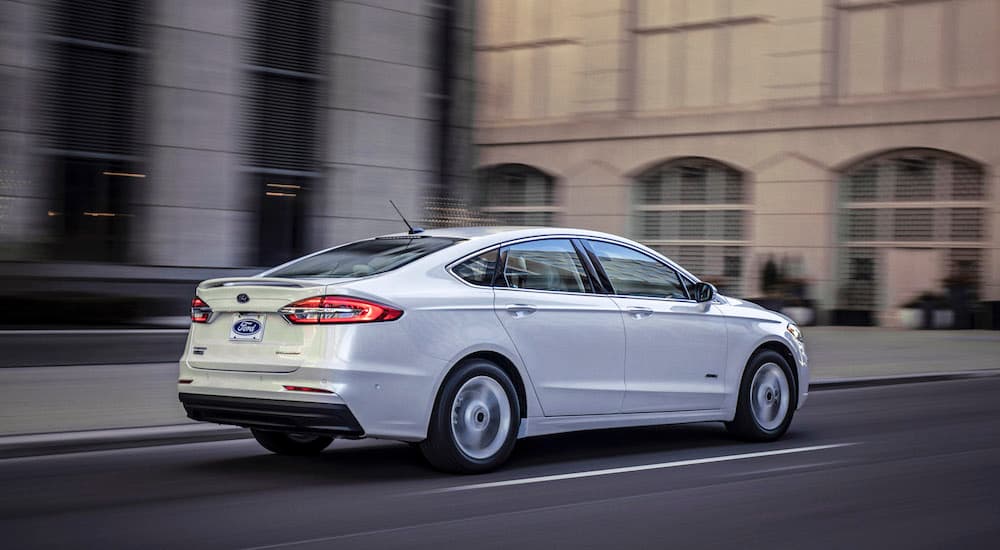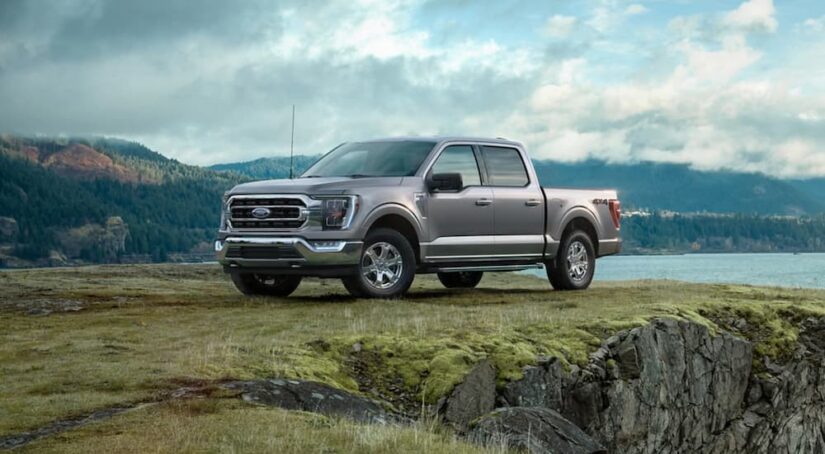You know the saying: “Built Ford Tough.” Who doesn’t know this saying if you’ve watched TV, read a magazine, or even seen an ad online in the last twenty-plus years? It can mean many things, but when you hear the word “tough,” it’s understandable if you don’t think about fuel efficiency but something that requires more grunt, like towing. Given that looking for a used Ford for sale is something Americans do every day, you may be wondering what the most fuel-efficient Ford vehicles you can find on the used market are. We’ve put together a list that’s sure to help guide you in the right direction.
Most Fuel-Efficient Trucks
Some pickup trucks are fuel hogs, and it’s not hard to see why. They have hulking exteriors, impressive towing abilities, and strong engines under the hood. However, not every truck is a money pit when you fill your tank, and there are a couple of examples within Ford’s lineup.
The Ford Ranger is the most fuel-efficient pickup truck in the lineup out of the gate, but it’s still not the best possible efficiency from a Ford truck. That honor goes to the larger F-150 if you fit it with the diesel powertrain. The problem is that the 2021 F-150 was the last model to offer a diesel powertrain, with the 2022 model reaching its best fuel efficiency ratings with the hybrid powertrain. Luckily, the hybrid powertrain has advantages too, such as better combined ratings and mileage in the city.
The diesel powertrain in the 2020 F-150 earns 21 MPG in the city and 29 MPG on the highway (24 MPG combined) with two-wheel drive. Four-wheel drive models impressively retain the combined ratings and city mileage but drop slightly to 28 MPG on the highway. With the turbo-diesel 3.0L V6 engine paired with a ten-speed automatic transmission, you also get the added benefit of 250 hp and 440 lb-ft of torque, along with a maximum towing and payload capacity of 11,500 and 2,020 lbs, respectively.
The 2022 F-150, with its turbocharged 3.5L V6 hybrid powertrain and ten-speed automatic transmission, nets you 25 MPG across the board with two-wheel drive, and 4WD models earn 23 MPG in all categories. Thanks to 430 hp and 570 lb-ft of torque, the hybrid models aren’t only comparable to the earlier diesel F-150 but exceed it, with a maximum payload capacity of 2,120 lbs and a maximum towing capacity of 12,700 lbs.
Where does the smaller Ford Ranger fall into the equation? It is a midsize truck, and aside from leaving a smaller footprint, you can also expect used prices to be lower than the F-150 if you compare trucks from the same model year. The Ranger has plenty of power on tap, with the 2020 model running exclusively on a turbocharged 2.3L I-4 engine paired with a ten-speed automatic transmission.
Any of the three available trims for the 2020 Ranger will net you 270 hp, 310 lb-ft of torque, a towing capacity of 7,500 lbs, and a payload capacity of 1,860 lbs. The 2021 Ranger remains the same but has a slight 2% increase in payload capacity to 1,905 lbs. The fuel economy ratings will depend on which drivetrain you buy. A two-wheel drive Ranger will get 21 MPG in the city and 26 MPG on the highway, with 23 MPG combined. Adding four-wheel drive drops these figures to 20 MPG in the city and 24 MPG on the highway, with 22 MPG combined.

Check Out the Ford Fusion
The Ford Fusion may not be in active development anymore, but the legacy it leaves behind is incredibly fuel-efficient sedans that are likely to last long into the future. The 2020 Ford Fusion was the last model released, which marked the end of a 15-year-long production cycle split between two generations. There were a few variations of the Fusion by the end of its life cycle, with variants like the Fusion Energi taking up the mantle as the PHEV solution and the Fusion Hybrid serving as the standard hybrid model.
From the fuel economy rating perspective, the Fusion Hybrid is amazing, with the 2020 model earning EPA-estimated ratings of 43 MPG in the city and 41 MPG on the highway, coupled with 42 MPG combined. Having 188 hp and 129 lb-ft of torque from the integrated 2.0L I-4 engine is rather performance for such an economical model. The standard Fusion also does quite well, with the 2020 model offering three powertrains: a 2.5L I-4, a turbocharged 1.5L I-3 engine, and a turbocharged 2.0L I-4 engine, all paired with a six-speed automatic transmission.
The standard 2.5L I-4 engine gets 21 MPG in the city, 31 MPG on the highway, and 24 MPG combined. The first of the two turbocharged powertrains, the 1.5L I-3 engine, earns the best ratings of the bunch, with 23 MPG in the city, 34 MPG on the highway, and 27 MPG combined. The strongest powertrain in the 2020 Fusion, the turbocharged 2.0L I-4, gave the sedan 245 hp and 275 lb-ft of torque, along with 21 MPG in the city, 31 MPG on the highway, and 25 MPG combined with front-wheel drive. All-wheel drive Fusion models get 20 MPG in the city and 29 MPG on the highway, plus 23 MPG combined.
Fuel-Efficient SUVs
Again, we’ll be looking at the 2020 models, and first up is the Ford Explorer. This is a supremely fuel-efficient three-row SUV, especially if you buy the hybrid model. There are four available powertrain configurations for the 2020 Explorer if you count the ST trim’s special variation of the turbocharged V6 engine, but none are quite as efficient as the 3.3L V6 HEV powertrain.
This powertrain, along with the other three options, all link to a ten-speed automatic transmission. It has it all, between an exceptional 318 hp and 322 lb-ft of torque, as well as EPA-estimated ratings of 27 MPG in the city, 29 MPG on the highway, and 28 MPG combined with rear-wheel drive. All-wheel drive models get 23 MPG in the city, 26 MPG on the highway, and 25 MPG combined. The 2020 Explorer’s standard turbocharged 2.3L I-4 engine does an admirable job, too, with its fuel efficiency ratings of 21 MPG in the city, 28 MPG on the highway, and 24 MPG with rear-wheel drive. All-wheel drive models get 20 MPG in the city and 27 MPG on the highway, with 23 MPG combined.
The Ford Escape is another fuel-efficient SUV. It is a wonderfully fuel-efficient compact SUV, and much like the Explorer, the HEV model can easily meet or surpass expectations. The 2020 Escape can be described as fuel-efficient in all of its powertrain configurations, but the standard turbocharged 1.5L I-3 engine paired with the eight-speed automatic transmission holds the best non-hybrid fuel economy ratings. The base powertrain earns 27 MPG in the city and 33 MPG on the highway (30 MPG combined) with the front-wheel drivetrain, and 26 MPG in the city and 31 MPG on the highway (28 MPG combined) with AWD.
However, the hybrid model with its Continuously Variable Automatic Transmission (CVT) takes the cake. This model matches a battery and electric motor with a 2.5 I-4 engine, resulting in an astounding 44 MPG in the city and 37 MPG on the highway (41 MPG combined) in front-wheel drive models. Adding all-wheel drive makes a massive reduction to city mileage to 23 MPG in the city and a slight reduction to combined ratings with 40 MPG, but ultimately retains the freeway rating of 37 MPG.

The Best Selection Available
If there’s one lineup you can trust for quality, it’s Ford. This holds true whether you’re talking about performance, body durability, or efficiency. The Ford vehicles mentioned here are great examples of the fuel efficiency you can find on the used market if you stick with the Ford brand.



